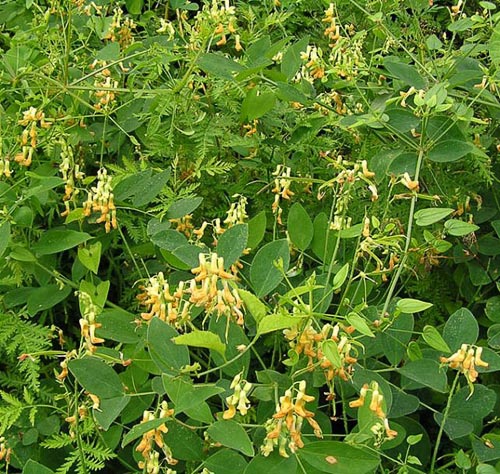Relatives
Lathyrus davidii Hence - David.s Pea.
Taxonomic position.
Family Fabaceae Lindl., genus Lathyrus L.MOrphology and biology.
Perennial plant 80-100 cm tall with straight or ascending stem, slightly climbing by means of leaf tendrils. Stem grooved, angular. Stipules large, 2-4(6) cm long, up to 1-2.5 cm wide, semisagittate, with entire or dentate margin. Rachis of lower leaves ends in a cusp, upper ones in a branched tendril. Leaves consist of 3-4(5) pairs of oblong-oval or slightly rhombic leaflets 5-12 cm long, 2.5-5(6) cm wide, somewhat glaucous beneath, with reticulate venation. Peduncles as long as or longer than leaves. Inflorescence a many-flowered raceme. Pedicel as long as calyx. Flowers large, 17-20 mm long, bright orange or rusty-yellow. Calyx broadly campanulate, above at the base inflated hump-like, upper teeth triangular, very short, lower ones lanceolate-subulate, long. Standard contracted slightly above its middle, on broad unguis; wings as long as standard, on long narrow bent unguis; keel triangular-oval, on long unguis. Ovary linear, narrowed toward base, glabrous. Ovules 20-25, style linear, glabrous. Pods smooth, stalked, 6-9 cm long, about 0.5 cm wide. Seeds ovoid-globous, brown, hilum as long as 1/5 of seed circuit. Flowers in June, fruits in July - August. 2n=14.Distribution.
General distribution: Far East, Japan, China. Former USSR: Far East - Ussuri area.Ecology.
Forests, forest glades and fringes, shrubberies, herbaceous slopes of dry hills.Use and economic value.
High-protein forage plant, well eaten by deers.References:
Shishkin BK., Bobrov EG., ed. 1948. Flora URSS. V.13. P.506. (In Russian).Kharkevich SS., ed. 1989. Vascular plants of the Soviet Far East. V.4. Leningrad: Nauka. P.311-312. (In Russian).
Cherepanov SK. 1995. Vascular plants of Russia and adjacent states (the former USSR). St.Petersburg. 990 p. (In Russian).


